Derek Chan and I have been friends for a little over four years. We both moved from Los Angeles to Chicago in the Fall of 2005. We had several mutual friends and emailed back and forth a few times but never met up. I spent that summer in Los Angeles and unknowingly started talking to Derek at a party. Inevitably, our conversation turned to Chicago and I laughed when I realized that this was the guy I’d had so much trouble making time for. Since then we’ve stayed close, meeting often to check in with each other, share food, and hang out.
One of Derek’s large abstract landscapes, Eclipse, was stored at my house for a year. I was happy to look at it every day. While works like Eclipse captured autobiographical moments with grand gestures, Derek has since focused his attention on the quotidian. During his residency at Theaster Gates’ Dorchester Project in South Chicago, Derek began making daily ink drawings to document his thoughts and share them with his fellow residents. All 260 images are available for download on Derek’s website. As part of the Whitney Biennial, Derek presented Being/Becoming, a durational performance that included ink drawings and temporary interventions to the Whitney’s courtyard. Derek developed a system of marks, influenced by Tibetan rituals, to record the passage of time and his interactions with museum visitors.
Cries and Whispers from the Salt Song Trail is a continuation of this practice. This forthcoming book chronicles his recent journey to the Four Corners region of Arizona through drawings and writings about the sacred places he visited. Golden Age, the project space I run in Chicago, is publishing Cries and Whispers in conjunction with Derek’s upcoming exhibition Derek Chan: A Way of Life at the Museum of Contemporary Art Chicago (November 6 – 28, 2010).

Derek Chan, "Cries and Whispers from the Salt Song Trail," 2010. Courtesy the artist and Golden Age.
Martine Syms: Tell me about this book.
Derek Chan: This book is a record of a few days of travel in the Four Corners region of the Southwest. More specifically, Northeast Arizona in Tuba City, Hopi Mesas, and Navajo Nation territory. The book is a combination of drawings and writings about the sacred places and people I encountered along the way. The book deals with everyday encounters, oral history, the mundane, and searching for the spiritual through pilgrimage. The sites that I visited have their own histories and are sacred to different people for different reasons. A few of these sites carry the weight of colonialism, conflicts with the U.S. government, and struggles for resistance. Mostly, I wanted to know how people pursue their way of life and find happiness in certain adverse situations such as a harsh landscape, foreign domination, or lack of resources.
MS: What is your idea of happiness?
DC: Self-acceptance, balance and optimism.
MS: Do you have any rituals?
DC: I try to take 5 minutes a day to give thanks and think about everyone who has come before me, loved and supported me. I have different spots around Chicago where I like to sit and do this before work. They are usually places off of my bike route. There have been periods of times when I have made drawings ritualistically too.
MS: Why make a book?
DC: I thought the book would be the best form to convey the narrative and the passage of time. I also like the fact that a book about travel can travel with a person. It’s interesting how a book can come in to a person’s life and just as easily change hands. I like to carry different sized notebooks and sketchbooks, so I hope that this book has something of that feel.
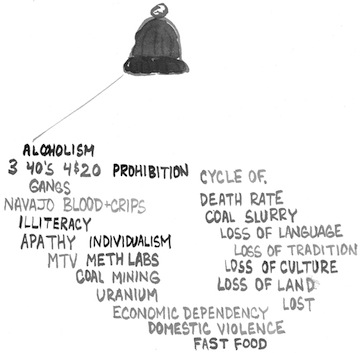
Derek Chan, "Cries and Whispers from the Salt Song Trail," 2010. Courtesy the artist and Golden Age.
MS: What is your favorite book?
DC: I-Ching (Book of Change) is one that I have gone back to often, but more recently I realized that I may not be using it correctly so I decided to put it aside for now.
MS: Why do you make drawings?
DC: There are times when I can communicate more directly through drawing than written language or speech.
MS: Where do your symbols come from?
DC: I use some universal symbols that may also contain specific local, cultural, sacred histories. I look at contemporary western modernism, but pull more from religious art in Tibetan, Chinese, and Japanese Buddhism, and more lately that of the Navajo and Hopi tribes.
MS: Why did you start doing your daily drawings?
DC: At the time, I was living in a communal living situation. I thought that making a commitment to daily drawings and sharing them was a devotional act to the immediate people around me. Making a commitment and following through was something that I was trying to get better at. Also, creating a structure where I had to draw every day kept me from making judgments about the quality or content of the drawings. It freed me to make something out of ideas, thoughts, small and big things that my own self-imposed limitations may otherwise have kept me from.
MS: Do you like to collaborate?
DC: I like to collaborate depending on the project and the collaborator. I think collaborations are always challenging, but if there is mutual respect, it can produce great results. Also, knowing that your decisions can have positive or negative effects on another person is a good motivator.
MS: How do you record ideas?
DC: I typically get most ideas outside of my studio. I either sit in the park, at a coffee shop, or at the Harold Washington Library.
MS: What tools do you use?
DC: Intuition, heart, an awareness of resources and community. A bike for transportation and health. Lately gouache, ink, and oil paint.
MS: Who are your favorite painters?
DC: On Kawara, all my peers and mentors in Chicago and LA.
MS: Are you obsessed with anything?
DC: I haven’t had the time to be obsessed with these things yet, but I would like to run a marathon and learn to surf. I like the idea of working towards a goal of experiencing the perfect race or ride.
MS: Were you creative as a child?
DC: Yes, I was creative as a child. I had an imaginary surf/skate clothing label that I would do the designs for.
MS: What were you like in high school? College?
DC: In high school, I found a community of other kids with similar interests, outside of my school and neighborhood. Discovering that world kept me out of the house a lot and was a mental escape for me during school. It was an amazing time to be in San Francisco. I had friends from all different parts of the city. One of our favorite places to meet was at a skate spot called Pier 7. Even then, art and other creative outlets allowed me to meet friends and taught me essential social and life skills.
In college, I found a strong community of Asian Americans at UCLA. Pursuing Asian American studies pulled me away from art for while, but I fell back into art during my last year and a half of college.
MS: How have you changed since then?
DC: Communicating is not as difficult. I also learned that I could choose the kind of adult that I wanted to be. I am better at acknowledging the positive things about myself, as well as the not so good, and I am open to change. I’m not quite as scared.

Derek Chan, "Cries and Whispers from the Salt Song Trail," 2010. Courtesy the artist and Golden Age.
MS: What do you do for fun?
DC: I like to ride my bike, let time pass at the lake, listen to new music my brother has sent me, visit with friends, and catch up with family. I also enjoy not working at work with my co-workers, joking, laughing, eating, reading, and occasionally looking for shoes on the Internet.
MS: In the movie Groundhog Day, Rita says she always toasts to “world peace.” What do you toast to?
DC: To that particular moment, to everyone in the room with me and to everyone that couldn’t be there.
MS: What is your favorite color?
DC: Yellow. The color of light.
MS: What is your favorite flower?
DC: Chrysanthemum.
MS: If you had three wishes, what would you wish for?
DC: I don’t want the world to end. Relative harmony. For everyone to have the basic necessities to be happy.
MS: What is your favorite word?
DC: Yes.
MS: What do you appreciate the most in your friends?
DC: I appreciate my friends’ companionship, appreciation of small things, kind gestures, and closeness over time despite distance.
MS: Who are your heroes?
DC: Yuri Kochiyama and my family.
MS: What is your motto?
DC: A little sand, but not the beach.
Derek Chan: A Way of Life runs November 6 – 28, 2010 at the Museum of Contemporary Art Chicago in the UBS 12×12 Gallery. Cries and Whispers from the Salt Song Trail: A Re-interpretive Journey will be available for sale beginning November 6. The publication is launching at the New York Art Book Fair and Golden Age is having a release party on November 6. More information can be found on their websites.
Martine Syms co-founded and runs Golden Age in Chicago.
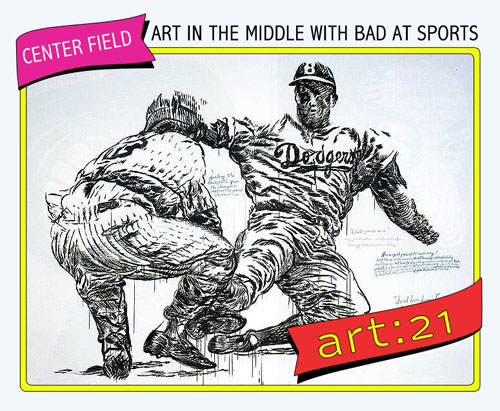
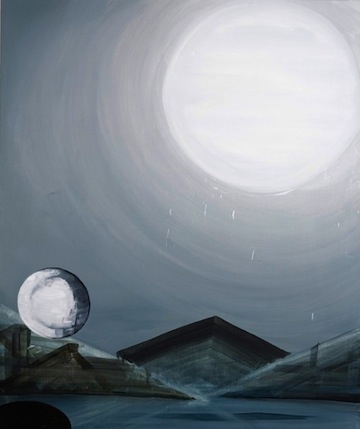
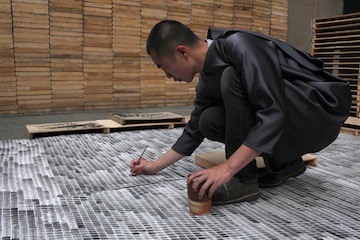
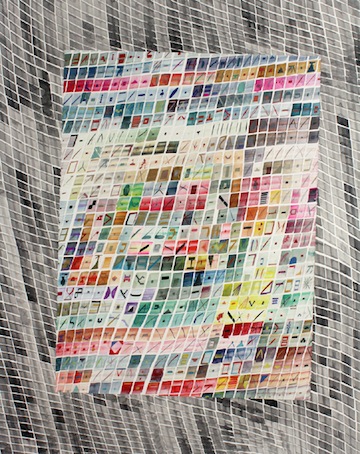



Pingback: Art 21-Center Field- Art in the middle with Bad at Sports – Derek Chan